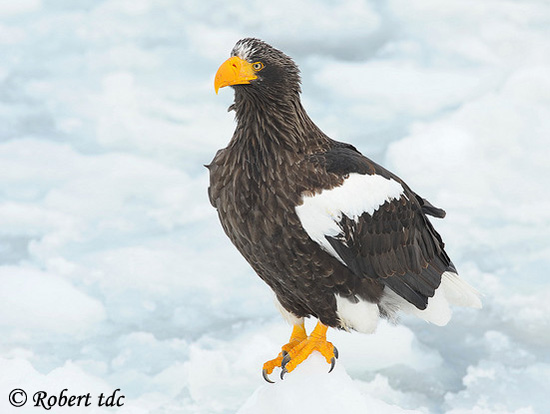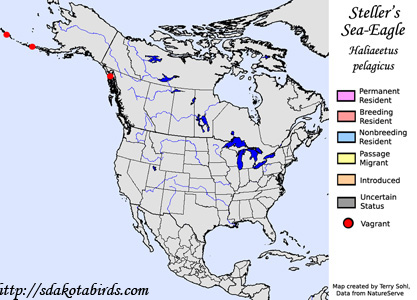Steller's Sea-Eagle
Haliaeetus pelagicus
| Length: 34 - 42 inches | Wingspan: 6.5 to 8.2 feet | Seasonality: Non-resident in South Dakota |
| ID Keys: Massive size, dark overall, powerful and large orange bill, white shoulders and tail | ||
 The
Steller's Sea-Eagle is a massive and powerful raptor of northeastern Asia,
this species has wandered a few times to North America, with strays found
along the Alaskan coast on occasion. They are one of the largest
raptors in the world, reaching weights of close to 20 pounds with wingspans
of over 8 feet. Like the Bald Eagle of North America, Steller's
Sea-Eagles, often congregate on river systems in the fall to take advantage
of massive numbers of dead salmon that have spawned.
The
Steller's Sea-Eagle is a massive and powerful raptor of northeastern Asia,
this species has wandered a few times to North America, with strays found
along the Alaskan coast on occasion. They are one of the largest
raptors in the world, reaching weights of close to 20 pounds with wingspans
of over 8 feet. Like the Bald Eagle of North America, Steller's
Sea-Eagles, often congregate on river systems in the fall to take advantage
of massive numbers of dead salmon that have spawned.
Habitat: During breeding season in northeastern Asia, Steller's Sea-Eagles either will nest along coastlines, or along rivers with adjacent mature forest land. During migration and in winter, they are often found on coastlines, rivers and water bodies around Japan, and even on the open sea-ice. Some birds also move to mountainous regions in the winter, where they evidently feed heavily on deer that die during harsh winters.
Diet: Steller's Sea-Eagles feed heavily on fish, and also will take many water birds, including birds as large as cranes, geese, and swans. They will also opportunistically feed on a variety of mammals, squid, crabs, carrion, and even young seals.
Behavior: Steller's Sea-Eagles forage by observing from a perch, or flying, diving to grab a fish or other prey item in their powerful talons. They will also steal fish and other prey from other bird species, or feed heavily on dead fish, dead dear, or other carrion when the opportunity arises.
Nesting: Steller's Sea-Eagles build massive stick nests, either on a cliff or in a large tree. Both parents help to raise the young.
Migration: Some birds are non-migratory, especially those that nest along coastlines. However, other birds do migrate, with some birds moving to Japan or Korea, and others making altitudinal migrations.
Interactive eBird Map: Click here to access an interactive eBird map of Steller's Sea Eagle sightings
Similar Species: White-tailed Eagle, Bald Eagle
Conservation Status: The IUCN lists the Steller's Sea-Eagle as "Vulnerable". Populations have been moderately declining due to habitat loss. They are also susceptible to lead poisoning, as they will readily feed on deer and other carrion that have been shot by hunters. Total global populations are likely well below 10,000.
Further Information: 1) National Geographic - Steller's Sea-Eagle
2) National Wildlife Federation - Steller's Sea-Eagle
3) Institute for Wildlife Studies - Steller's Sea-Eagle
4) Birdlife International - Steller's Sea-Eagle
Photo Information: February 29th, 2008 - Robert tdc - Photo licensed under Creative Commons Attributions Share-Alike 2.0 Generic License.
| Click below for a higher-resolution map |
 |
| South Dakota Status: Non-resident in South Dakota. |
Additional Steller's Sea-Eagle Photos (coming soon!!)
